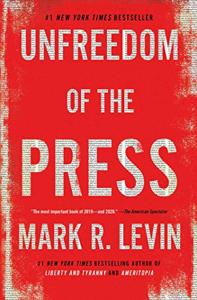
Want to learn the ideas in Unfreedom of the Press better than ever? Read the world’s #1 book summary of Unfreedom of the Press by Mark R. Levin here.
Read a brief 1-Page Summary or watch video summaries curated by our expert team. Note: this book guide is not affiliated with or endorsed by the publisher or author, and we always encourage you to purchase and read the full book.
Video Summaries of Unfreedom of the Press
We’ve scoured the Internet for the very best videos on Unfreedom of the Press, from high-quality videos summaries to interviews or commentary by Mark R. Levin.
1-Page Summary of Unfreedom of the Press
Overview
The world is undergoing huge changes. People are getting their news from social media and the line between fact and fiction is becoming blurrier than ever before. Critics on both sides of the spectrum lament this state of affairs, citing a rise in “fake news”.
People on the left side of the political spectrum believe that President Trump lies all the time. On the right, people think that mainstream media is too focused on unimportant stories based on anonymous sources and speculation.
But Mark R. Levin goes even further than that, and says that the mainstream media is actually controlled by the Democratic Party. He believes that they’re working together to make Trump’s job of governing as hard as possible, because they want to harm him politically.
In this article, you’ll learn about pseudo-events and why the media used to be more balanced. You’ll also read how the New York Times ignored the plight of European Jews during World War II.
Big Idea #1: Having a free press is vital for a functioning democracy, but the modern United States press is far from free.
In Western democracies, the media is supposed to be free. But in America, it has been sick for a long time.
Our story begins in 1947, when the citizen-led Commission on Freedom of the Press released a report that sheds light on today’s media landscape.
While the media has become more available, its quality has decreased. The press is increasingly inflammatory and sensationalist in their reporting, as well as irresponsible.
The Commission also emphasized the importance of media in educating people about important values.
In the past, scholars have tried to define what a free press should be. In 2007, for example, Bill Kovach and Tom Rosenstiel concluded that the most important duty of the press is to equip citizens with information they need in order to govern themselves.
A free press is a vital part of society, and one way to ensure it’s working properly is by making sure there are a variety of different types of journalists. That ensures that the most important ideas have been presented in an unbiased manner.
There are many great journalists in the United States, but they tend to be liberal. A study found that 28.1% of journalists identify as Democrats and only 7.1% identify as Republicans.
The news media are mostly liberal. This is a huge problem because the public trusts them, and they’re not trusted by those who don’t share their views.
These statistics show that most of the media share the same political ideology as the Democratic Party.
The media are responsible for making extreme left-wing positions appear mainstream. This happens because the media give a lot of coverage to those views, which makes them seem more acceptable than they really are.
Big Idea #2: The American media of the past was blatantly political but balanced, and only later attained a fake aura of objectivity.
To understand the sorry state of American media today, we must look at how we got into this mess in the first place.
In the years leading up to the American Revolution, pamphleteers were allowed to publish their opinions freely. However, unlike modern news networks that claim objectivity, these pamphleteers were extremely biased in their reporting. Thousands of publications against British rule were distributed during and before the Revolutionary War.
The media in the United States was biased even after the revolution. Newspapers were often partisan, and they would support one politician while criticizing another.
However, this was not to last. Around the turn of the 20th century, America experienced a shift in governance as left-wing presidents began leading the country.





